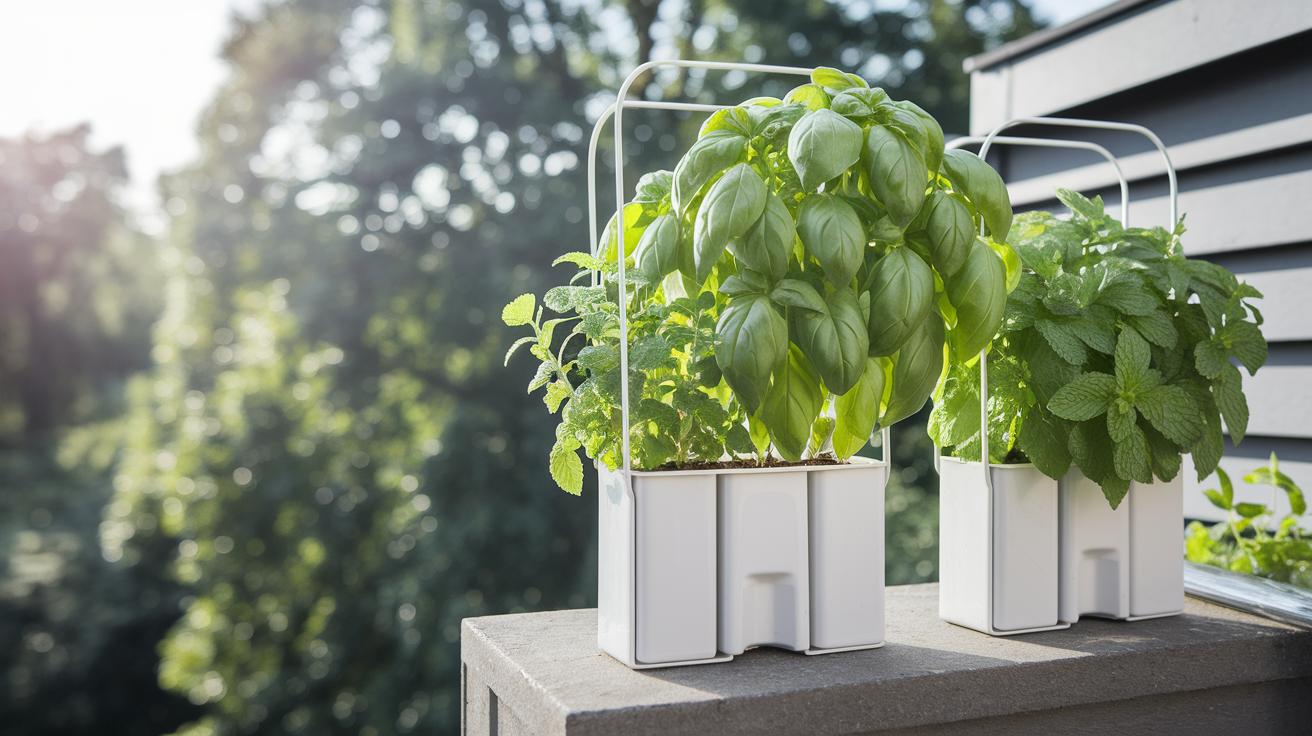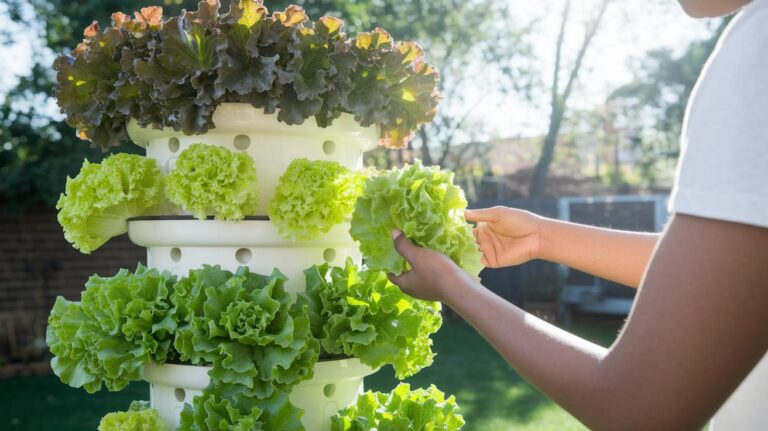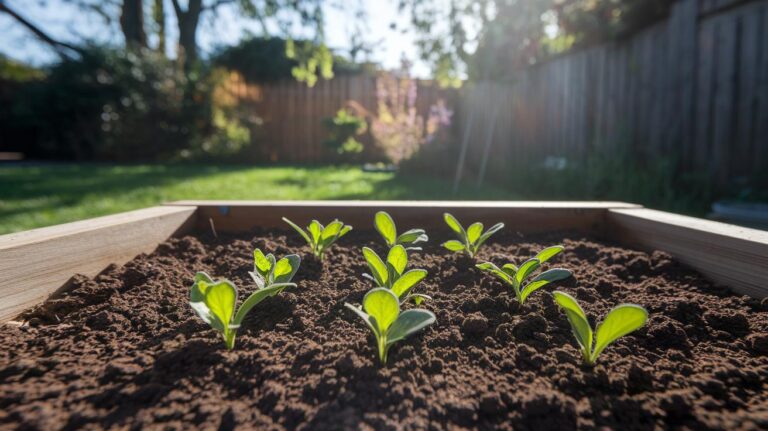Best Vertical Herb Garden Kits Amazing Affordable Picks
Think you need acres for fresh herbs? Nope. Vertical herb garden kits (planter systems you hang on walls or fences) let you tuck sweet-smelling basil (green, fragrant leaves), cool mint (refreshing, scented herb), and bright parsley (leafy green garnish) into even the tiniest sunny nook.
They hang on fence boards, brick walls, or balcony railings. That frees up ground space for juicy tomatoes or cheerful marigolds. By the way, my cat loves sunning on the fence beside mine, so cute, right?
I’ve tested felt pockets (soft fabric pouches), stackable tiers (layers you stack up), and cedar planters (wood boxes that resist rot). I’ll walk you through my top picks, they’re stylish, simple, and kind to your wallet.
And your kitchen counter? Get ready for a parade of fresh greens and happy flavors!
Top-Rated Best Vertical Herb Garden Kits for 2024
Ever wished you could tuck fresh herbs into a sunny wall instead of sprawling them across your yard? Vertical planters let you stack basil, mint, and parsley like little green flags waving hello.
I’ve tried a few favorites for every style, budget-friendly towers, stackable spice pots, and even a DIY wooden palette. Here’s a quick tour of the best kits I’ve tested in my own backyard.
| Kit | Material/Design | Capacity | Price | Pros | Cons |
|---|---|---|---|---|---|
| Cedar-Wood Pocket Planter | Cedar wood (durable, rot-resistant) | 6–8 grow pockets (small planting spots) | $70–$90 | Looks great; sturdy; cedar scent keeps pests away | Needs sealing now and then |
| Felt-Pocket Garden | Felt fabric (breathable, water-resistant) | 12–16 slots (spaces for seedlings) | $50–$80 | Roots breathe easy; super light; just hang it up | Sun can fade or weaken the fabric |
| Stackable Plastic Pots | Modular plastic tiers | 9–12 pots | $60–$100 | Move pots around; low fuss; easy to rinse clean | Feels a bit plastic instead of earthy |
| GreenStalk 5-Tier System | Recycled plastic panels with reservoir (built-in water holder) | 30 pockets; 5 cu ft soil capacity (about 40 gallons) | $90–$100 | Water reservoir cuts down watering; built-in drainage holes | Rotate the tower so sun hits all sides; mostly plastic |
Material & Design Options in Best Vertical Herb Garden Kits
Have you ever imagined your kitchen wall alive with fresh herbs? These vertical garden kits come in three main styles. Each one has its own feel and care needs.
First, there’s the hydroculture column (a hydroponic system feeding plants through water). You’ll get a steady flow of nutrients and skip daily drips. Perfect under your grow lights. But, uh, you need a pump setup and it costs a bit more at the start. I once forgot to plug in the pump, oops, my basil gave me a stern reminder.
Next up, the fabric pocket filled with soil (decayed organic matter that enriches soil). Roots love its breathable sleeves. A UV resistant liner helps it last longer. Still, water spots can sneak in and the fabric can fade if it lacks a liner. By the way, my cat can’t resist kneading those little pouches.
Then there’s the fir wood frame (softwood from the fir tree). It has a smooth finish and feels lighter on your wall. It’s often friendlier on your wallet too. Just remember to reapply a waterproof seal every few months. Mine gets a fresh coat each spring, right before I plant.
Pick what fits your space and schedule. No matter which style you choose, you’ll be snipping herbs off the wall in no time.
| Design | Pros | Cons |
|---|---|---|
| Hydroculture Column | Steady water flow frees you from daily drips Great for indoor spots under grow lights |
Needs pump setup Higher upfront cost |
| Fabric Pocket (Soil) | Roots breathe in breathable sleeves UV-resistant liner boosts lifespan |
Water spots can form Fabric may fade without liner |
| Fir Wood Frame | Lighter, smooth finish Often friendlier on your wallet |
Needs more frequent waterproof sealing |
Installation & Maintenance Tips for Your Best Vertical Herb Garden Kit
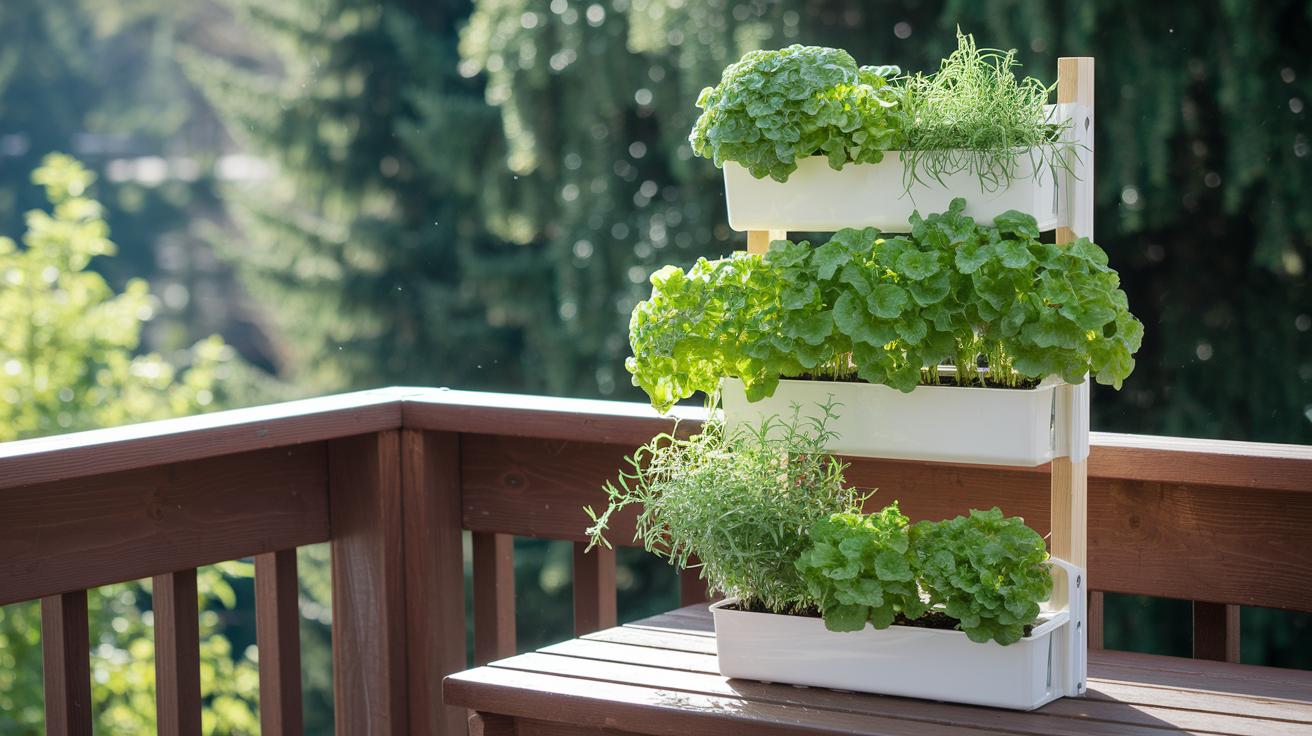
Got your kit and ready to mount it? Let’s prep. You’ll need a power drill (to make holes), a level, screwdriver bits, screws, and anchors. Wood or plastic kits often include basic screws. But felt-pocket gardens need heavy-duty anchors to cope with extra weight when they’re soaked.
Step-by-Step Assembly
- Use the level to mark your spots. Then drill small pilot holes.
- Screw in the brackets or anchors. Follow your kit instructions.
- Hang the pockets or slip on the trays. Check that each row sits perfectly level.
- Slide a catch tray under the bottom tier. Good drainage stops water from pooling.
- Fill each pocket or pot with light potting mix blended with peat moss (decayed organic matter that holds moisture) and vermiculite (tiny sponge-like bits that give roots air and water).
That’s it for setup. Oops, almost forgot: make sure each layer feels sturdy before planting your herbs.
Now for upkeep. Stick with this five-point guide to keep your green friends happy:
- Water your pots every two or three days. Aim for soil that feels like a damp sponge.
- For drip irrigation or reservoir systems, add water once a week. Peek at the levels instead of drips every day.
- If your bins don’t have holes, drill some to let extra water escape.
- Rinse plastic trays now and then. This stops salt from building up.
- Each season, swap in fresh mix so roots get plenty of air.
For more hands-off watering ideas, check our self watering vertical herb garden.
Price & Space Suitability of Best Vertical Herb Garden Kits
Most vertical herb garden kits cost between $50 and $100. Budget options at $50 have lighter frames and simple designs. Splurge-worthy models around $90 to $100 come with sturdy stands, drip watering (a gentle tube that feeds each pocket), or recycled plastic that stands up to sun and rain. You’ll see they last longer.
These garden towers fit 6 to 16 herb pockets and reach from 2 ft to 5 ft tall. A short, 2 ft kit with six little pockets slides onto a windowsill or a slim corner inside. Imagine brushing your fingers against soft basil leaves every time you walk by! Taller 4 or 5 ft pieces hug balcony rails or skinny patios without blocking your path.
You’ll choose freestanding or wall-mounted frames based on your space. Freestanding kits stand right on your patio floor. Wall-mounted models free up every inch of ground space. If frost or shifting sun spots worry you, look for kits with wheels or set the frame on a rolling cart so you can wheel your herbs into bright sun or a cozy corner when cold snaps hit.
For more small space vertical herb garden ideas, see how to turn tiny spots into a full-on herb wall.
Best Herbs & Growing Tips for Vertical Herb Garden Kits
Have you ever dreamed of snipping fresh herbs right from your wall?
A vertical herb garden kit is just the ticket. Basil loves shallow, well-drained pockets. These shallow spots keep water moving so roots won’t sit in soggy soil. When you tuck in a basil plant, you’re in for that sweet, peppery whiff each time you clip a leaf. Give it six to eight hours of sun, or at least three hours of gentle morning rays for a softer flavor.
Parsley and thyme are your next pals. Parsley needs its soil just damp (not soaked), so water lightly and pinch off any yellow stems to make room for fresh green shoots. And thyme? Plant it in the top rows where water drains fast. Thyme likes good airflow – its roots dry out quickly, so it won’t mind skipping a drink now and then.
Grouping herbs by how much they thirst makes watering a breeze. Mint, for example, sends roots down deep and can actually jostle out a little extra moisture for its neighbors. So pop mint into lower pockets. Then trim back its runners often, and you’ll keep it from taking over the whole tower.
Think of your soil like a sponge – it soaks up moisture then needs a little fluffing to breathe. At the start of each season, top off with organic potting mix (bagged soil with compost, which is decayed organic matter that enriches soil). If you skip daily watering, sprinkle in a slow-release nutrient pellet (tiny balls that feed plants for weeks). Oops, spilled a pellet thought there. That fresh mix, made with peat moss (decayed moss fibers) and vermiculite (tiny mineral balls), holds just the right amount of water and lets roots relax.
Planting now sets you up for a summer harvest. Happy gardening!
Buying Guide: Choosing the Best Vertical Herb Garden Kit
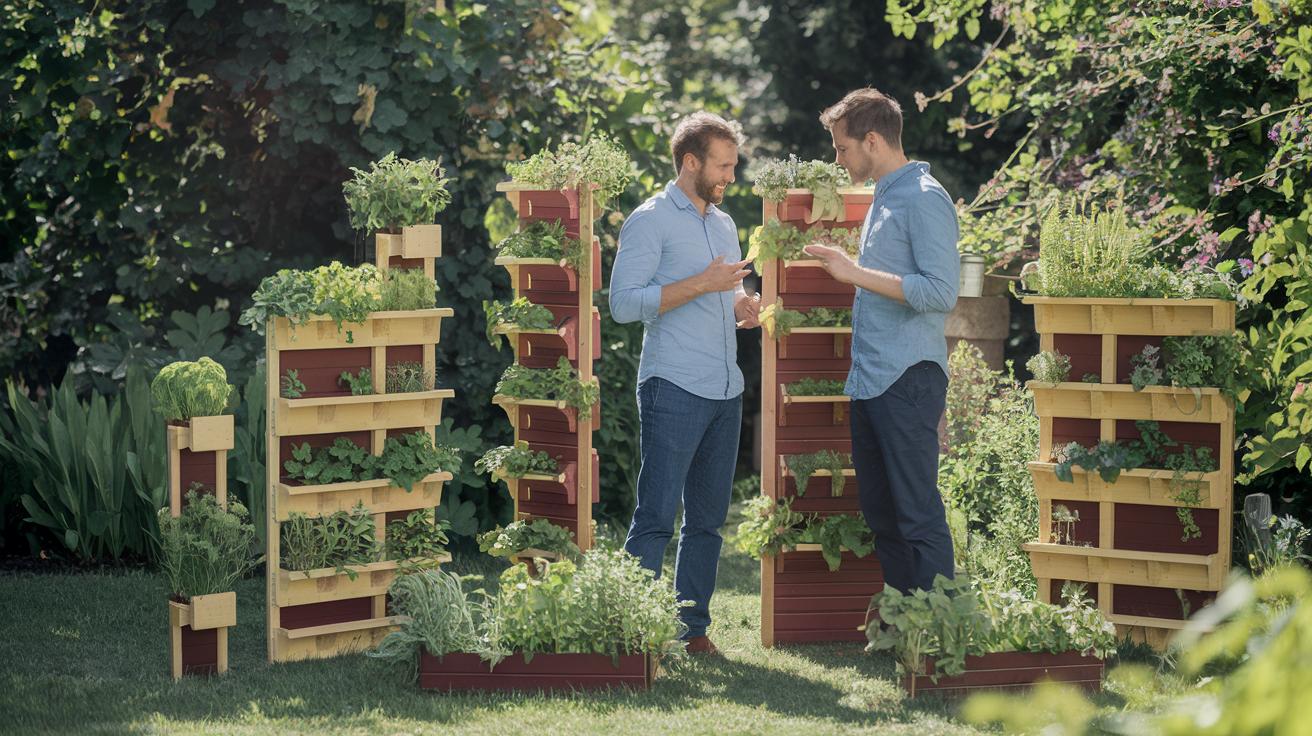
Got your tape measure ready? Awesome. First, pick the spot where you want those herbs to live. You need about six hours of sunshine or three hours of gentle morning rays. Ever smelled basil on a morning breeze?
Here’s an easy checklist to help you choose a kit that fits perfectly:
- Measure width and height (dimensions means how wide and tall). Make sure that patch of wall or fence sees plenty of sun.
- Check slot count, material, and watering style. You might pick wood, recycled plastic, or felt pockets (soft fabric plant pouches you can feel between your fingers). Look for a drip line (thin tubes that water each pocket) or a built-in reservoir (a little water tank under the slots). Don’t forget the screws, hooks, and all the hardware.
- Pick a mounting style and care level. Freestanding frames roll if you move them. Wall-mounted models free up floor space. Fabric pockets need heavy-duty anchors so they don’t sag with wet soil.
- Compare prices and warranties. Top brands usually cover one to three years and let you swap a broken planting pod.
- Read customer reviews and brand trust scores. The best kits earn over 80% satisfaction, while budget-friendly ones hover near 70%.
And don’t skip the return policy. Life happens. Maybe that rack won’t fit your balcony rail. With a good return plan, you can swap it out and still end up with fresh basil or cilantro within arm’s reach.
Planting your vertical garden now means fresh herbs all season.
Oops, I once hung a rack upside down and had to laugh as I flipped it right.
Final Words
In the action of weighing cedar-wood, felt-pocket, and stackable systems plus the 5-tier GreenStalk, you saw key specs and price points side by side. Now you have a clear snapshot to find a kit that fits.
We also covered frame materials, mounting tricks, watering routines, and simple upkeep tips. You’ve got clear steps for setting up and caring for your kit.
Then we chose herbs that thrive in tall towers and walked through a simple purchase checklist. Now you’re ready to pick the best vertical herb garden kits for your space and enjoy homegrown flavor all season long.
FAQ
Which vertical herb garden kits are best for outdoor use on Amazon?
The best vertical herb garden kits available on Amazon for outdoor use include the cedar-wood pocket planter, felt-pocket garden, stackable plastic pots, and GreenStalk 5-tier system for easy setup and durability.
What is a vertical planter tower?
A vertical planter tower stacks pots or pockets around a central column, saving ground space while letting you grow multiple herbs or veggies in one tall, narrow footprint.
How do vertical planter walls work outdoors?
Vertical planter walls hang pockets or modules on a sturdy frame or wall, letting roots grow downward and keeping plants close to sunlight without taking up patio or deck floor space.
What options exist for vertical gardening systems?
You’ll find wood frames with fabric pockets, plastic modular pots, and self-watering towers. Each system varies in material, slot count, and watering features to match sun exposure and plant needs.
How can I start an outdoor vertical garden?
You can hang a pocket planter on a fence or wall, or place a freestanding tower on a patio. Fill with light potting mix, water every few days, and pick sun-loving herbs.
How do hydroponic vertical gardens grow herbs?
Hydroponic vertical gardens pump nutrient-rich water through stacked channels, so roots get oxygen and food without soil. You just refill the reservoir, adjust pH, and watch herbs thrive.

